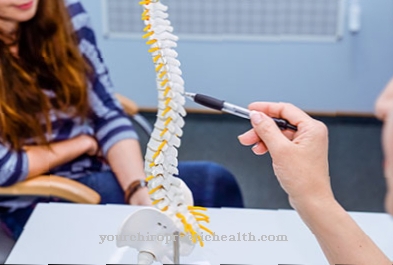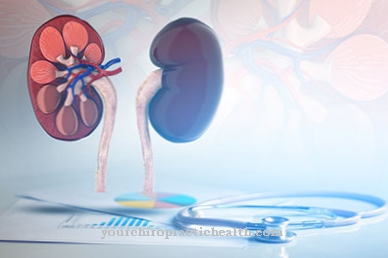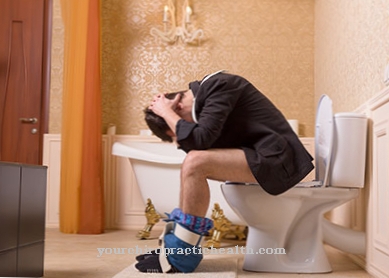Constant excessive demands on sports can lead to pain in the Achilles tendon over time. The Achillodynia consequently results from a permanent overload.
What is achillodynia?

Achillodynia describes the painful damage to the Achilles tendon, although the disease occurs almost only in active people and is one of the most common sports injuries.
The cause is usually a long-term overload or incorrect loading of the Achilles tendon. Therapy is usually done with non-surgical methods. If the damage is recognized and treated early, the progression of the disease can be prevented or at least stopped.
causes
Achillodynia primarily arises from excessive or incorrect loading of the Achilles tendon during sport. Not only professional athletes but also recreational athletes can suffer from this, especially runners, soccer and tennis players, ballet dancers and triathletes. Fast running or jumping movements in particular lead to increasing wear and tear on the Achilles tendon. Doctors refer to wear and tear as "degenerative change".
Mainly the lower area of the Achilles tendon on the heel is often affected, as the Achilles tendon is usually not supplied with blood, which means that injuries do not heal. Stress constantly causes microtraumas (tiny damage) to the Achilles tendon. If the tendon is regularly overloaded, there is a disproportion between the numerous small microtraumas and the Achilles tendon can only regenerate to a limited extent.
How quickly achillodynia develops depends on various factors, for example the general level of physical training, the type of load, the duration, frequency and intensity. Incorrect footwear during sports or in everyday life can lead to incorrect loading of the foot, which puts excessive strain on the Achilles tendon. Other possible causes are treatment with cortisone, as this can damage the connective tissue and thus the tendons, old age, obesity, foot misalignments such as arched feet or metabolic diseases such as increased uric acid and fat levels in the blood.
Symptoms, ailments & signs
In most cases, achillodynia develops slowly. First of all, those affected only feel a slight pinch in the Achilles tendon, which is especially the case in the morning after getting up, after long breaks from sitting or at the beginning of running training. Initially, however, this disappears after a little movement. Typical for the disease are load-related pain that occurs in the lower back of the leg and in the heel.
A stiffness of the Achilles tendon in the morning can also be a sign. In the further course, the complaints in the Achilles tendon increase until they can finally appear at night or at rest. If you ignore the initial pain and continue training, you can develop protracted achillodynia, which usually occurs during exercise. The Achilles tendon is swollen, overheated and reddened in this case.
Diagnosis & course
In the case of achillodynia, the diagnosis begins with the anamnesis (medical history). The doctor asks a few questions about the symptoms and sports behavior, for example, since when pain has existed in the Achilles tendon, whether previous damage is known in this area, when the pain is strongest, which sports are practiced, how often people train, whether or not pain in the Achilles tendon is felt during exercise.
This is followed by the physical examination, during which the doctor looks at the Achilles tendon and feels it. Achillodynia often shows thickening of the Achilles tendon and small nodules. The doctor can also check whether certain foot movements in the Achilles tendon lead to pain.
Another way to make the diagnosis is with an ultrasound scan. Achillodynia can be seen on the screen. An MRI scan can also provide information. This allows inflammations and the smallest tears in the Achilles tendon to be shown in detail.
Complications
Achillodynia is a painful overload of the Achilles tendon. The pain usually occurs in the morning after getting up. At times the foot seems to crunch when moving. If the symptoms persist, the pain can also occur at night during the rest phase.
The ability to walk becomes increasingly limited the longer the symptom is ignored. The pain forces the person affected into a kind of equinus foot position so that the tendon is relieved. As a consequence of the complication, there is constant pain from the heavily thickened Achilles tendon. Problems with the Achilles tendon can be experienced by older people and athletes after a long break from training.
In particular, rapid and spontaneous changes in load irritate the Achilles tendon. This must be able to withstand the strong pulling forces at all times. The tendon ensures that the heel rises and falls when running, jumping, dancing, and hiking. If the symptom is not consistently treated medically, there is a risk of chronic inflammation of the tendon, which leads to further complications.
A heel spur threatens, the tendon tissue calcifies and can even tear. The degeneration process can also affect the surrounding tissue, blood vessels and nerves. It takes many weeks for achillodynia to heal. During this time, the patient has to relieve the Achilles tendon and, depending on the findings, is given a drug to reduce pain and inflammation.
When should you go to the doctor?
Achillodynia should be evaluated by a doctor. Treatment is not necessary in every case. With the help of an examination, however, consequential damage and other painful complications can be avoided and limited. For this reason, pain in this region of the body should not be left untreated. Especially with further exertion, inflammations or cracks can occur, which lead to a restriction of movement.
The person concerned should then consult a doctor if there is pain in the lower legs or in the heels that occurs during exercise. In most cases, the body appears very stiff after getting up in the morning. This complaint can also be a symptom of achillodynia and should always be investigated. The other complaints usually occur during daily exercise or during certain sports. A doctor must also be consulted if, in addition to achillodynia, there is also a misalignment of the foot or if the person concerned is overweight.
Doctors & therapists in your area
Treatment & Therapy
As a rule, the treatment of achillodynia is purely conservative, i.e. not by surgery. Only if the treatment is unsuccessful is surgery necessary in rare cases. Conservative therapy aims to relieve the Achilles tendon, especially in the case of acute complaints. For this, the triggering load, for example jogging, must first be interrupted in order to protect the foot.
Only when the pain has completely subsided can it be fully used again. The doctor can also give you pain medication. Special insoles for shoes and exercises that can be learned in physiotherapy and show the person affected how to properly load the foot are also helpful. Surgical treatment of achillodynia either splits the tendon skin or removes parts of the changed tissue.
Outlook & forecast
First and foremost, achillodynia causes relatively severe pain in the patient. This pain occurs mainly in the lower leg or on the heel. The pain usually results in severe mobility restrictions. This means that ordinary activities and sporting activities are no longer easily possible for the person concerned.
If the pain also occurs in the form of resting pain, it can lead to sleep problems. The Achilles tendon is very stiff, especially in the morning after waking up. In most cases, the pain does not go away on its own and there is no spontaneous healing.
The pain increases with further stress. This can lead to infections and inflammation without treatment. This further restricts the patient's movement and, in some cases, the patient can no longer perform any sporting activities after treatment.
In most cases, the treatment of achillodynia leads to a positive course of the disease. This is mainly done with the help of medication and physiotherapy. In severe cases, the tissue can also be removed. Achillodynia does not change life expectancy.
prevention
Achillodynia can best be prevented if you avoid excessive and improper exercise during sport. The training should be increased slowly, because the body needs some time to get used to new stimuli. It is also important to give the organism enough time to regenerate between training sessions. It is also important to pay attention to suitable sports shoes and to consider their lifespan.
Over time, the sole can change and lead to incorrect loads. Ultimately, of course, it is also important to listen to your body, because it is important to understand pain in the Achilles tendon as a warning signal instead of ignoring it. Frequently occurring symptoms can be an indication of achillodynia.
Aftercare
The painful conditions of achillodynia are usually closely related to the stress on the relevant structures. Therefore, in the aftercare, a focus should be placed on not stressing the tissue too early and, above all, not overstressing it. This is especially true for athletes who, due to their ambitions, often tend to start training too early and thus accept the risk of a relapse.
If you are training again, it is essential to ensure consistent warm-up and stretching exercises for the corresponding area as part of the aftercare. The resumption of stress should be discussed with the orthopedic surgeon or family doctor. Appropriate footwear is very important after achillodynia.
In this context, the shortening of the tendons, which could cause the achillodynia to flare up again, should be avoided. Shoes with higher heels can promote this shortening. Rehabilitation shops and orthopedic shoemakers are the right address for the right footwear.
Exercise and strain that strain the calf muscles automatically strain the Achilles tendon area as well. Therefore, it can be beneficial to switch to other types of sport than the usual as part of aftercare if the basic fitness is to be rebuilt. Massage of the calf muscles counteracts cramps, which could also have a negative effect on the Achilles tendon. Magnesium is an effective remedy for those with a tendency to cramp.
You can do that yourself
Since achillodynia usually occurs as a result of (too) strong stress on the Achilles tendon, it is possible for those affected to take preventive measures. When the stress is no longer present, the achillodynia also disappears in most cases. Until the person is completely free from pain, the sport or activity that triggered them should therefore be avoided. The symptoms usually subside after a few days.
In order to prevent achillodynia, athletes should ensure that they allow sufficient recovery periods between training units. In addition, it is important to warm up intensively before a possible exercise and, if possible, not to overload the body. Even if these basic rules are observed, damage to the Achilles tendon can be reduced and regeneration can be promoted. If you experience pain after exercising, it can help to cool the Achilles tendon. Kinesiological tapes can be suitable to protect the tendon from stress.
The right footwear can also help in everyday life as well as during training. An orthopedic shoemaker is the right place to go for foot misalignments, otherwise a specialist shop. Women shouldn't wear high heels too often and for too long. This can lead to a shortening of the tendons, which subsequently causes achillodynia.


.jpg)
.jpg)
.jpg)






















